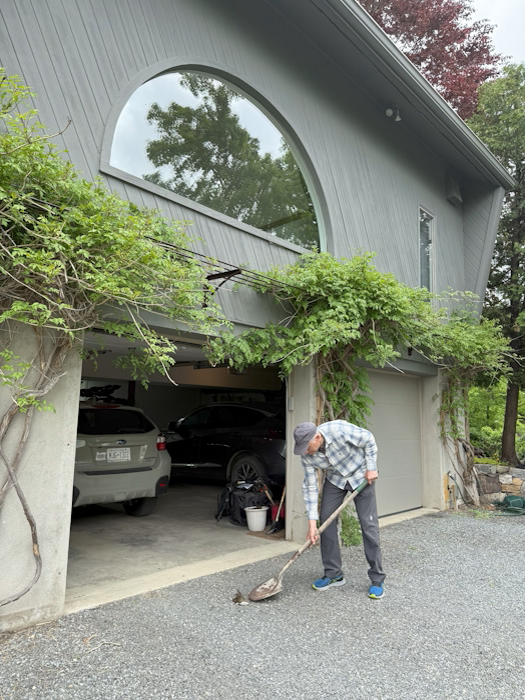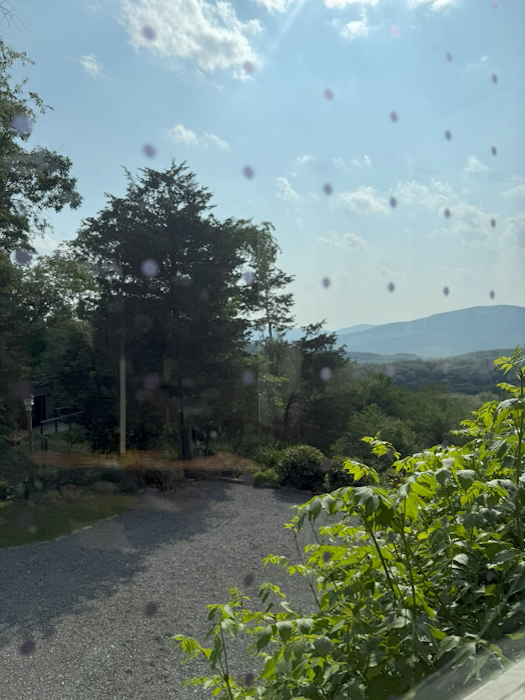When my wife Johanna and I moved to the Highlands five years ago, we didn’t intend to become bird killers. But that’s what happened.
We live on a hill off Route 301 in Philipstown, near Fahnestock State Park. The master bedroom has a picture window about 15 feet above the driveway with a view of the woods and the hills above the Hudson River. “I won’t ever get tired of that view,” my wife said while touring the house.
Little did we know that about a dozen times a year, we’d hear birds crash into that window, often breaking their necks.
There’s typically a loud bonk. We then find tufts of sad, grey feathers stuck to the pane. Below the window we usually find a bird, often dead, its head twisted horribly. My wife assigned me the job of hurling the corpses into the woods with a shovel. If the bird was still breathing, my wife gently moved it to the grass. Sometimes it would fly away, but sometimes it died.

“We’re a menace,” Johanna said after finding a soggy corpse under one of our back windows after the snow melted.
It’s true. Our windows have killed cardinals, woodpeckers, robins, blue jays, sparrows, an oriole and, most recently, a yellow-billed cuckoo.
Those are just the birds we noticed. We’re likely killing two or three times that, said Christine Sheppard of the Glass Collisions Program at the American Bird Conservancy. Even if birds survive, Sheppard said, they may be weakened enough to become easy prey.
After hearing about our house, Sheppard said it sounded like a perfect storm for bird killing because we live in the woods near the Hudson, a migration highway. My wife’s garden and our two feeders are also an attraction. “You do have a bad house,” Sheppard said. “Birds don’t understand glass. The windows reflect that beautiful view and they fly right through.”
Last month, during migration season, we participated in a webinar offered by the Cornell Lab of Ornithology on how to stop bird collisions. For the record, a bird hit our window during the webinar.
Windows kill an estimated 1 billion birds annually in the U.S., said Tina Philips, a Cornell scientist who led the webinar: 44 percent hit houses and 56 percent hit low-rise office and apartment buildings. Despite perceptions, high-rise buildings kill few birds.
Birds “are programmed over millions of years to take these migrations of thousands of miles,” Philips said. “We have introduced buildings and glass into their landscape in the last 100 years or so. Evolution doesn’t happen that fast.”
Windows are the third-leading cause of a 25 percent drop in the U.S. bird population in the last 50 years, Philips said. The leading killer is habitat loss, followed by cats: 100 million outdoor cats kill 2.4 billion birds annually.
In 2019, New York City amended its building code to require glass and building materials that birds can see. State legislators have proposed similar measures such as the FLACO (Feathered Lives Also Count) Act, named after Flaco, the Eurasian eagle-owl that escaped the Central Park Zoo and died last year after crashing into a building on the Upper West Side.
To prevent bird strikes, the Cornell Lab recommends bug screens, window stickers, special glass and curtains with cords that hang over the window.

For our picture window, we applied a film with a grid of gray dots 2 inches apart. After a day, we didn’t notice the dots, but birds see them. We’ve had no strikes on that window since.
Applying the film is technical and done by experts like Jamie Dohrenwend of Hudson Valley Window Film in Wappingers Falls. He said he mostly applies coatings for security, safety, privacy, glare reduction or UV protection. Once a month, he gets calls from bird killers.
We may be sending him more work. A bird died the other day by our front-door window. It was another yellow-billed cuckoo, a breed deemed threatened out west because of habitat loss. In the Hudson Valley, they’re still plentiful, for now.
For more information on preventing bird deaths, see the guides created by the Cornell Lab (dub.sh/prevent-bird-hits) and the American Bird Conservancy (abcbirds.org/glass-collisions).


Thank you to Joey Asher for fixing the problem with his “habitat” and explaining how to do so. Wind farms are another way countless bird strikes occur, but they are rarely mentioned.
According to the American Bird Conservancy, a group we cited in the story, the number of birds killed by wind turbines in the U.S. could reach 1.4 million annually by 2030 if the U.S. meets its goal of producing 20 percent of electrical energy with wind. That compares to the conservancy’s estimates of 2.4 billion bird deaths caused annually in the U.S. by cats and 1 billion by window strikes.
Thank you for this well-informed article. Besides just being beautiful and songful, birds are important for pollination, seed dispersal, pest control and maintaining healthy ecosystems. And, they were here first. But with thoughtfulness, compassion and action like Joey and Johanna have shown, we can get better at living in harmony.
Thanks to Joey Asher for his timely article. My wife and I now have three bird feeders around the house and have noticed some birds crashing into the windows by the front door. We assumed they believed they were attacking another bird, but Joey has given me cause to rethink this. For some reason, most of the birds enjoy the feeder at the back and don’t crash into the bay window.